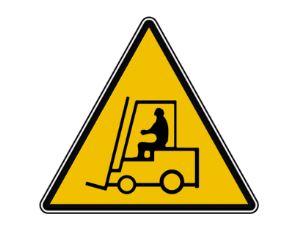Working with Forklifts

The purpose of this alert is to remind forklift users of the inherent dangers of using a forklift.
Background
WorkCover recently responded to two incidents where, in each incident, a worker was injured while a load was being shifted nearby with a forklift. In the first incident, a worker received crush injuries when chains used to suspend the load slipped off the tynes, causing the load to fall. In the second incident, while attempting to place a heavy concrete pit onto a rack with a forklift, the pit toppled onto a worker.
Contributing factors
Investigations are continuing. However, in both incidents, the procedures for lifting, transporting and lowering the load did not ensure the stability of the load at all times. Also, other workers near the forklift were not safely positioned.
Action required
Employers and workers who operate forklifts should note the following:
· Employers must ensure that plant is safe when properly used. They must develop and implement safe systems of work and ensure that employees are provided with the information, instruction, training and supervision that’s required to ensure their health and safety at work.
· Forklift operators must be trained and hold a relevant license. They also must be competent at operating the forklift in the environments in which they are required to work.
· Before lifting a load, the weight, size, shape and composition of a load should be considered, along with the terrain that the forklift will be travelling over. Loads must only be lifted, carried and stored in a manner that ensures stability at all times.
· When carrying loads, avoid sudden or heavy braking that could cause the load to slide forwards.
· Employers must provide appropriate equipment to lift and transport loads, which for forklifts could mean using specially designed attachments when the tynes alone are not suitable. However, attachments must only be used if such use is allowed by the manufacturer. Load rating for the combined use of the attachment with the forklift should be prominently displayed.
· Slip on attachments should be secured to prevent accidental disengagement from the supporting tynes. Do not sling loads from tynes, as there may be a risk of the sling sliding off the tines. If necessary (and allowed by the manufacturer), use a jib or other specifically designed attachment to carry underslung loads.
· Employers must implement controls to prevent forklifts colliding with pedestrians or other mobile plant. These could include traffic management plans, signage, proximity warning devices, ‘no-go’ and ‘pedestrian only’ areas, site layout, using safely positioned spotters and other similar measures
· Forklifts have numerous blind spots, especially if the carried load obstructs forward view. Operators should ensure other persons are excluded from the area and, remain in view at all times.
MLA Holdings Pty Ltd takes forklift safety seriously. That is why we are partnered with a leading manufacturer of forklift products and attachments, who has developed Magnetic Fork Covers. The forklift operator can install the magnetic covers on the forks in a matter of seconds, improving stability and decreasing the chances of the load slipping off the forks.
For further forklift safety information contact MLA on 131 652 or www.mlaholdings.com.au. Information for this article was sourced from www.safety.unsw.edu.au.
Download PDF here

